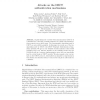Free Online Productivity Tools
i2Speak
i2Symbol
i2OCR
iTex2Img
iWeb2Print
iWeb2Shot
i2Type
iPdf2Split
iPdf2Merge
i2Bopomofo
i2Arabic
i2Style
i2Image
i2PDF
iLatex2Rtf
Sci2ools
CTRSA
2009
Springer
2009
Springer
Attacks on the DECT Authentication Mechanisms
Digital Enhanced Cordless Telecommunications (DECT) is a standard for connecting cordless telephones to a fixed telecommunications network over a short range. The cryptographic algorithms used in DECT are not publicly available. In this paper we reveal one of the two algorithms used by DECT, the DECT Standard Authentication Algorithm (DSAA). We give a very detailed security analysis of the DSAA including some very effective attacks on the building blocks used for DSAA as well as a common implementation error that can practically lead to a total break of DECT security. We also present a low cost attack on the DECT protocol, which allows an attacker to impersonate a base station and therefore listen to and reroute all phone calls made by a handset.
Cryptology | CTRSA 2009 | DECT | DECT Standard Authentication | Digital Enhanced Cordless Telecommunications |
| Added | 19 May 2010 |
| Updated | 19 May 2010 |
| Type | Conference |
| Year | 2009 |
| Where | CTRSA |
| Authors | Stefan Lucks, Andreas Schuler, Erik Tews, Ralf-Philipp Weinmann, Matthias Wenzel |
Comments (0)

